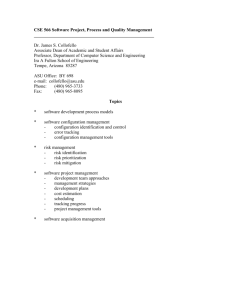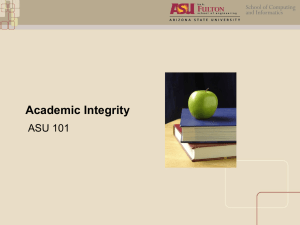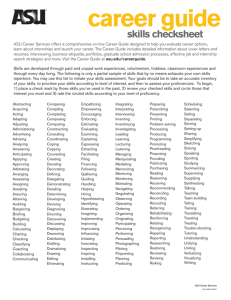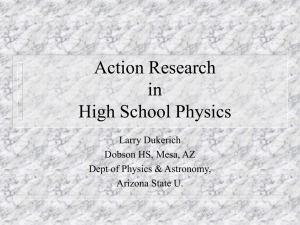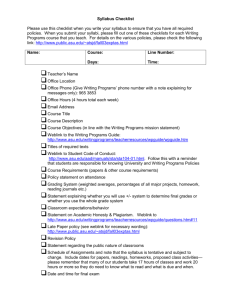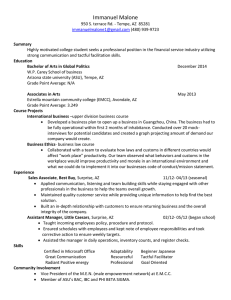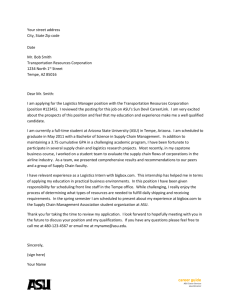ď - Sites
advertisement
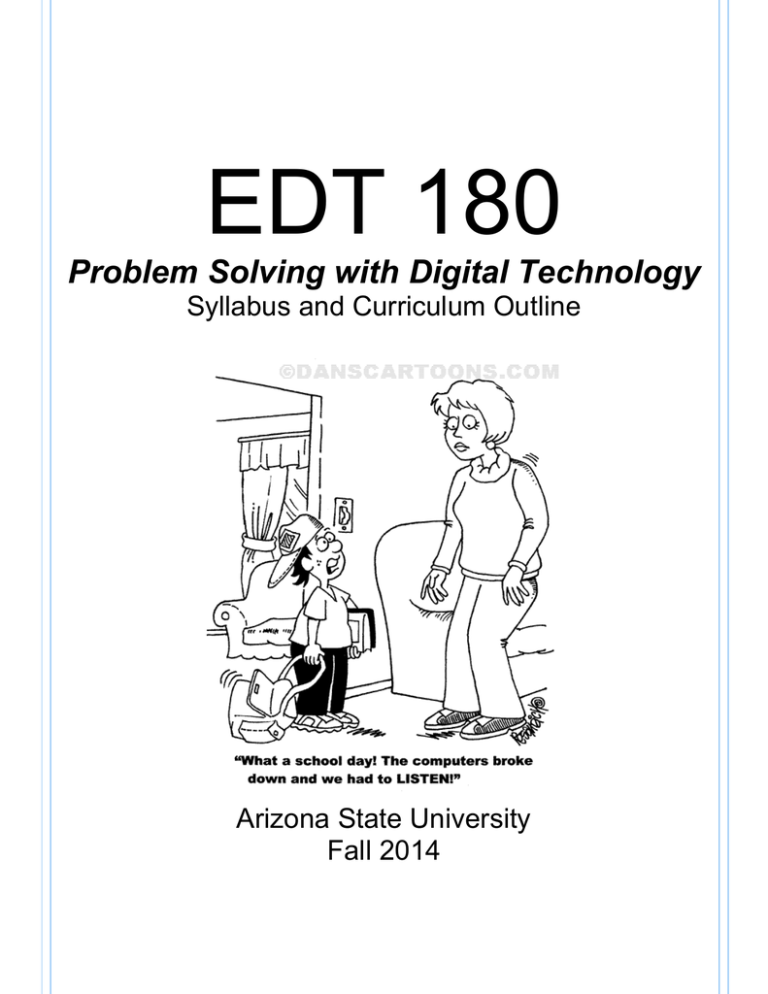
EDT 180 Problem Solving with Digital Technology Syllabus and Curriculum Outline Arizona State University Fall 2014 White-Taylor – 2014 EDT 180 - Syllabus and Curriculum Outline PART 1-RULES AND REGULATIONS Instructor In Person Office Hours Course Line Number Class Time Class Location The best way to contact—Email Dr. Janel D. White-Taylor By appointment via ASU - Email minimum 24 hours in advance sln 91377 and 86584 TTH 10:30am and Noon Tech 169 and AGBC 116 drj@asu.edu COURSE OVERVIEW This course presents an overview of modeling, simulation, probability, and the role of technology in education and business. Exploration and presentation of emerging technology will be investigated along with their acquisition, use and implementation into society. Course includes the use of software programs and online simulations for scientific investigation, internet research, data collection, visual representation of data, probability and measures of central tendency, Action Research, modeling and web page design. COURSE FORMAT EDT 180 is conducted in a student-centered environment, which requires active student participation. This means that the instruction features illustrated lectures, on-line research and discussion, student generated information, demonstrations, and hands-on activities and projects. Students are active participants in their own learning experience. When assistance with technology tools is necessary, ASU offers the following as support to computer-using students: Technology Studio: Each campus hosts a laptop help office for any brand of laptop. Free assistance is available with on-campus Wi-Fi connectivity, virus problems, and other software and hardware issues. At-home access: 602-543TECH. Walk-in access for West (Sands 125), Downtown (University Center, Information Commons), Tempe (Computing Commons, 140), and Poly (Academic Center Building, Lower Level) Student Computing: Each campus has a computer access area with most of the equipment and software needed for this course. Staff is available for basic technical assistance but cannot provide support related to the content of this course. Walk-in availability is at West (Technopolis in the basement of Fletcher Library), Downtown (Information Commons in the lower level of the University Center building), Tempe (Computing Commons building or Payne 122), and Poly (Computer Lab in the Center building). Lab for Education Students: On the West campus, the Intel Lab is located in CLCC 206; on the Tempe campus, the Education Multimedia Lab is located in Payne 122 (8am-8pm M-F). These labs are available for education student use on a varied schedule. When open, the lab personnel are available to assist students primarily with multimedia projects associated with coursework. The schedule is located at http://www.west.asu.edu/MLFTC/intel/ Help Desk: The ASU Help Desk provides phone and online support to students 24 hours a day, 7 days a week. Students can request help with their own computer, report a problem with university services, and track progress. Contact: 480-965-6500, helpdesk@asu.edu, or chat via http://help.asu.edu My ASU: Is a personal start page that combines ASU Interactive and resources to create an enhanced personalized experience. Members of the ASU community to be able to find all of the resources they need at https://webapp4.asu.edu/My ASU/ Technology Fee: The technology fee provides course software licenses as well as hardware provided for student use in the technology labs. In addition, the fee covers student course support via the help desk and virtual office costs. COURSE OBJECTIVES The terminal goal of EDT180 is Modeling, Inquiry, Analysis and Representation into technology tools that can be employed into education, business and personal life. The course has two areas of concentration: 1. Being able to discuss issues surrounding computers, software and the use of technology in the classroom and workplace fluently. 2. Demonstrating one’s ability to use computer applications, modeling and simulations for scientific investigation, Internet research, data collection, visual representation of data, probability, measures of central tendency, inferential statistics, Action Research, and web page design. Page 2 of 14 White-Taylor – 2014 EDT 180 - Syllabus and Curriculum Outline Students are provided a solid introduction to computers and the software applications they will use in their professional and personal lives. Upon completion of this course, students will be able to do the following: Review the significance of copyright, fair use, plagiarism and creative commons. Review the following in an online fashion: o how to use MS Word, Excel, and PowerPoint at an intermediate level, o how to use Google Docs (Word Processing, Spreadsheet, Presentation, and Forms) at an intermediate level, o how to utilize Google search functions in an effective way, and, o how to build a website using Google Sites at an intermediate level. Become familiar with contemporary and emerging educational technologies through weekly online discussions. Create a short screencast with closed captioning to teach a basic concept and upload it to YouTube. Collect and analyze data using the functions of spreadsheet software Use a minimum of three formulas to analyze data. Create data-appropriate visual representations of data. Create a presentation on an emerging technology with the intent to “sell” that technology. Utilize collected data to support their position and include both a numerical and visual representation of the data within presentation. Conduct research to assess daily personal and scholarly use of Internet and use the findings to answer a number of research questions. Use critical thinking skills to determine appropriate experts on chosen topic. Find the probability of a simple event. Describe the relationship between the probability of an event happening and not happening. Identify overlapping and mutually exclusive events. Use theoretical probability to conduct and replicate an experiment and compare results. Construct and interpret bar graphs, line plots, histograms, and double bar graphs. Determine the appropriate graphical display for a given set of data and contextual situation. Construct and interpret bar Box and whisker plots, stem and leaf plots, tally charts, and circle graphs. Determine the appropriate graphical display for a given set of data and contextual situation. Compare the outcome of an experiment to predictions made prior to performing the experiment, given a graph. Calculate probability, measures of central tendency in addition to constructing graphs to visually display data and draw conclusions in a written report following project details. Given an Action Research Case Study, Identify a sample population, design and construct a survey for data collection, analyze data and recommend a course of action based on analysis. Calculate and determine the appropriateness of measures of central tendency. Use a computer simulation of projectile motion to conduct an experiment and write a report to detail findings. Create a web page utilizing currently accepted design standards. Embed video in the web page. Include / upload files to web page. Demonstrate electronic information management habits (e.g. backing up files, organizing files in a logical fashion, transferring files to various storage areas) in the appropriate situations. Discuss and analyze the functions of computers in classrooms, businesses, homes, and other environments. Analyze and discuss social and ethical issues related to the increased use of technology in education, business, and society. Be able to conduct simple linear regression to make predictions Be able to conduct dependent and independent samples t-tests using MS Excel to analyze realistic situations that would typically happen at a K-12 school environment. REQUIRED MATERIALS 1. Students must have an ASURITE ID in order to participate electronically in the course. To obtain a student ASURITE ID and an email account go to http://www.asu.edu/asurite. ALL course email goes to your ASU address. Click the Activate your ASURITE UserID selection and follow the directions. Be sure to make a note of your password in a secure place. Only help desk personnel will be able to supply this password in the futureinstructors do not have access to this passwords and are unable to reset passwords. Page 3 of 14 White-Taylor – 2014 EDT 180 - Syllabus and Curriculum Outline 2. ASU Blackboard Course shells at https://webapp4.asu.edu/My ASU/ (All ASU students have FREE access to this web resource) 3. Microsoft Office Suite 2007 (especially Word and PowerPoint)-The Microsoft Office Suite is installed on all student-access computers on campus. Office is also available for purchase through the ASU bookstore. a. PLEASE NOTE: Microsoft WORKS is not compatible with WORD, thus documents created in Works cannot be read by campus computers. 4. Reliable device or method to back up and transfer dataa. Preferred: USB drive (also known as Jump, Flash, or Pen drives). 5. Web-based activities and projects available on Blackboard 6. Online Resources (Adaptive Curriculum) ATTENDANCE POLICY Class work is mandatory; however, circumstances happen during the course of the semester. In the event that you miss a class, please contact the instructor immediately. PLEASE NOTE: In class assignments cannot be made up. You must be present in class in order to receive credit for all in class work. EMAIL COMMUNICATION POLICY Emails will be responded to within 24-48 hours. Please make sure to email me from your ASU email account. instructors cannot respond to messages sent from other email accounts per university policy. LATE ASSIGNMENTS Any assignment (projects) submitted after the scheduled due date is considered late, unless previous arrangements have been made with the instructor and/or written and official excuses are presented to the instructor. Late assignments can only be accepted up to two weeks after the scheduled due date. All late assignment grades will be reduced by 25% within the first week after the deadline and by 50% within the second week after the deadline. All quizzes will be administered in class and make-ups will be given if and only if a student can present written and official excuse. DIGITAL BACKUPS Students frequently ask for an extension when their computer or storage device crashes and they lose an assignment. A backup storage device is a requirement for this course; it is expected that you dutifully back up your digital work. You will not be granted an exception for late work in a situation where a document or machine crashes. Please practice safe storage by backing up your documents. GRADING SCALE AND CLASS PROJECTS Grades will be recorded in Blackboard. Please verify periodically for accuracy (BB > Tools > My Grades). Final grades will be calculated based on the following scale (number of points you received divided by number of points possible): Overall Score Letter Grade 100.0 – 90.0 89.9 – 80.0 79.9 – 70.0 69.9 – 60.0 59.9 – 0 A B C D E CLASS PROJECTS Large Projects Technology Portfolio Points 270 Page 4 of 14 White-Taylor – 2014 EDT 180 - Syllabus and Curriculum Outline Participation Points 150 E-Book and Project 100 Technology in Your Field Analysis 50 Our Cause 45 App Project 40 Screen Capture 40 Total Class Points Technology Portfolio Topics 695 Points Technology Dynasties 10 Web Pages 25 Cloud Storage 10 Word Processing 20 Spreadsheet 20 Presentation 20 Browser and Search Engines 10 Mind Mapping 10 Photo Editing 10 Video 20 Video Conferencing 10 Animated Video 10 Social Media 15 Copyright 20 Games 30 Surveys and Forms 20 Mobile Technologies 10 Total Points for the Technology Project 270 Note: Mary Lou Fulton Teachers College may require anyone receiving a grade of D or E (failing) to retake the course. COURSE ASSIGNMENTS This course will cover computer applications used in education and business. These applications will include Google Documents, Google applications, word processing, spreadsheets, design and presentation, Online Resource, and Google Sites. Page 5 of 14 White-Taylor – 2014 EDT 180 - Syllabus and Curriculum Outline In the process of learning about software and technology packages such as Microsoft Office, we will be doing hands-on learning projects and researching how technology can be integrated into both the work place and into classroom learning activities. Some of these projects will be completed using topics you select. In addition, there will be online readings on various areas of technology, along with online simulation and modeling lessons data collecting, analysis, interpretation and representation and probability analysis. The course will also include a project on action research where we will conduct a research project and analyze data collected. In order to complete instruction in data collecting, analysis, interpretation and representation along with probability analysis, we will use a learning environment known as Online Resource (Adaptive Curriculum)©. These interactive online simulation and modeling lessons, known as “activity objects” (AO’s,) will contain animation, modeling and simulations that will allow students to have hands on training in all of the concepts listed above. In a typical lesson, students will first watch a video and then participate in a set of activities. After the completion of lesson, students will be given a short quiz. Each of the modules will be discussed briefly below: COURSE/INSTRUCTOR EVALUATION The course/instructor evaluation for this course will be conducted online 7-10 days before the last official day of classes of each semester or summer session. Response(s) to the course/instructor are anonymous and will not be returned to your instructor until after grades have been submitted. The use of a course/instructor evaluation is an important process that allows our college to 1. help faculty improve their instruction, 2. help administrators evaluate instructional quality, 3. ensure high standards of teaching, and, 4. ultimately improve instruction and student learning over time. Completion of the evaluation is not required for you to pass this class and will not affect your grade, but your cooperation and participation in this process is critical. About two weeks before the class finishes, watch for an e-mail with "ASU Course/Instructor Evaluation" in the subject heading. The email will be sent to your official ASU e-mail address, so make sure ASU has your current email address on file. You can check this online at the following URL: http://www.asu.edu/epoupdate/. Page 6 of 14 White-Taylor – 2014 EDT 180 - Syllabus and Curriculum Outline MARY LOU FULTON TEACHERS COLLEGE POLICIES Professional Behavior: o It is expected that students exhibit professional behavior inside the classroom, during intern placements, and working with other students outside of the class on assignments related to this class in addition to behavior in the classroom on ASU’s campus. o If at any time your behavior is ‘unprofessional’, the instructor may complete a Professional Improvement Plan (PIP) for the student. Writing Expectations: o All assignments and written communications in this class (including email and discussion board postings), are expected to be word-processed and conform to University-level writing standards. Your writing should be professional, clear, and when appropriate or required, include proper citations of expert knowledge and media in American Psychological Association (APA) format. Errors in spelling and/or grammar are expected to be rare. Colloquial, informal (texting-style) writing is not appropriate for formal or informal communications. o When grading or reviewing student work that does not meet these standards, your instructor will return the work for revision. The revised assignment will be issued ZERO points until resubmitted. Revisions will be due at the beginning of the next class session. Once re-graded, 10% of the total points possible will be deducted from your score. If more than one assignment is rejected for writing issues, a Personal Improvement Referral may be submitted to your department chair. At their discretion a Personal Improvement Plan may be issued. o The course BlackBoard shell contains a tutoring button with web-based resources to help you with your writing skills in areas such as APA, grammar, second language issues, etc. Additionally, the Learning Enhancement Center on campus offers one-on-one support for students. This center is in the basement of the library. Appointments are recommended. FERPA and Privacy Regulations o The Family Educational Rights and Privacy Act (FERPA) and ASU policies are designed to protect student privacy. The following is a brief overview of the main ways your private information will be treated in this class: o Your name and ASU email address are available in BlackBoard to all other enrolled members of the class. Your name may be used as a folder and/or document name on a network server used in conjunction with the class. These services are integral to this course; there is no way to use them anonymously. o Your instructor will not discuss your grades in the presence of anyone else even if you give verbal permission to do so. It takes WRITTEN authorization from you for an instructor to share any of your private information. o Your instructor may request written authorization from you to facilitate communications and the sharing of information. You are free to accept or reject these requests for authorization. If you do not understand any of these policies, ask your instructor or consult ASU privacy policies at http://www.asu.edu/aad/manuals/acd/acd121.html Academic Integrity/Plagiarism o The ASU Student Handbook contains the following information: “The highest standards of academic integrity are expected of all students. The failure of any student to meet these standards may result in suspension or expulsion from the university and/or other sanctions as specified in the academic integrity policies of the individual academic unit. Violations of academic integrity include, but are not limited to, cheating, fabrication, tampering, plagiarism, or facilitating such activities. The university and unit academic integrity policies are available from the Office of the Executive Vice President and Provost of the University and from the deans of the individual academic units.” Page 7 of 14 White-Taylor – 2014 EDT 180 - Syllabus and Curriculum Outline The rest of the code, which consists of several pages, is available at the following URL. http://www.asu.edu/studentaffairs/studentlife/judicial/academic_integrity.htm Disability Accommodations for Students o Religious Accommodations for Students o ASU policy prohibits harassment on the basis of race, sex, gender identity, age, religion, national origin, disability, sexual orientation, Vietnam era veteran status and other protected veteran status. Violations of this policy may result in disciplinary action, including termination of employees or expulsion of students. Contact Student Life (Downtown campus 522 N. Central Ave., Post Office Room 247, 480-496-4111; Polytechnic campus Administration building suite 102, 480-727-1060; Tempe campus Student Services Building room 263, 480-965-6547; or the West campus UCB 301, 602-543-8152) if you feel another student is harassing you based on any of the factors above; contact EO/AA (480-965-5057) if you feel an ASU employee is harassing you based on any of the factors above. Grade Appeals o A student who is a member of the National Guard, Reserve, or other U.S. Armed Forces branch and is unable to complete classes because of military activation may request complete or partial administrative unrestricted withdrawals or incompletes depending on the timing of the activation. For information, please see http://www.asu.edu/aad/manuals/usi/usi201-18.html. Harassment Prohibited o Students who need to be absent from class due to the observance of a religious holiday or participate in required religious functions must notify the faculty member in writing as far in advance of the holiday/obligation as possible. Students will need to identify the specific holiday or obligatory function to the faculty member. Students will not be penalized for missing class due to religious obligations/holiday observance. The student should contact the class instructor to make arrangements for making up tests/assignments within a reasonable time. Military Personnel Statement o Students who feel they may need a disability accommodation(s) in class must provide documentation from the Disability Resource Center (Downtown campus UCB 160, Polytechnic campus Sutton Hall 240, Tempe campus Matthews Center, or West campus UCB 130) to the class instructor verifying the need for an accommodation and the type of accommodation that is appropriate. Students who wish accommodations for a disability should contact DRC as early as possible (i.e. before the beginning of the semester) to assure appropriate accommodations can be provided. It is the student’s responsibility to make the first contact with the DRC. The professional responsibility for assigning grades is vested in the instructor of the course, and requires the careful application of professional judgment. A student wishing to appeal a grade must first meet with the instructor who assigned the grade to try to resolve the dispute. The process for grade appeals is set forth in the undergraduate and graduate catalogs, which are available at http://www.asu.edu/catalog Electronic Communication o Acceptable use of university computers, internet and electronic communications can be found in the Student Code of Conduct (http://www.asu.edu/aad/manuals/usi/usi104-01.html ) and in the University’s Computer, Internet, and Electronic Communications Policy (http://www.asu.edu/aad/manuals/acd/acd125.html). o Discussion boards and email communications are an important instructional tool in this course. Here are some of the most important rules for this class regarding the use of discussion boards and email: o Do not say anything in the discussion that you would not say in a face-to-face classroom situation. Use your professional judgment. o Contributions to discussion board should be for “the good of the group”; email your instructor directly with questions or issues that only apply to you. Page 8 of 14 White-Taylor – 2014 EDT 180 - Syllabus and Curriculum Outline o Be polite. Choose your words carefully. Do not use derogatory or sarcastic statements. o Contribute constructive comments and suggestions. o “Flaming”-expressing anger, often rudely-has no place in a classroom situation, either in the discussion area or in private email. Students receiving any sort of inappropriate email from other students should forward a copy to the instructor. o Do not use all capital letters. This is considered to be “shouting,” and is therefore rude. Likewise, do not use all lower case letters. In other words, use professional writing, not “IM” writing. o The Q&A discussion board located in our Blackboard shell is meant for questions and answers that would benefit you as well as your classmates. Please post “good for the group” questions there. Questions of a personal nature should be emailed directly to the instructor. NOTE: The instructor reserves the right to make adjustments to the syllabus as necessary throughout the semester. Page 9 of 14 White-Taylor – 2014 EDT 180 - Syllabus and Curriculum Outline PART 2-CURRICULUM OUTLINE AND TIMELINE Page 10 of 14 STANDARDS ADDRESSED Student Learning Outcomes Students will learn introductory skill sets for Word, Excel and PowerPoint using hands-on project-based learning NETS-T 1b, 2a, 2b, 2c, 2d 3a, 4a, 4b, 4c, 5b, 5c, NETS-S 1a, 1b, 1c, 1d 2a, 2b, 2d 3a, 3b, 3c, 3d 4a, 4b, 4c, 4d 5a, 5c 6a, 6b, 6d Students will review, learn, and implement concepts in mathematics, sciences, and statistical applications in real life examples and applications using a variety of methods 1a, 1b, 1c, 1d 2a, 2c, 2d 3a, 3b, 3c, 3d 4b 1c, 1d 2b, 3b, 3c, 3d 4c 6a, 6b, 6d Students will design, conduct, and analyze original research using technology and web based resources 1a, 1c, 2a, 2b, 2c, 3a, 4a, 4b, 1a, 1b, 1c, 1d 2a, 2b, 2d 3a, 3c, 3d 4a, 4b, 4c, 4d 5a, 5b, 6a, 6b, 6d InTASC 1a, 1b, 1d, 1e, 1g, 2c, 2d, 3b, 3c, 3e, 3g, 3i, 3j, 3m, 4b, 4c, 4d, 4g, 4h, 4i, 4j, 4k, 4l, 4m, 4n, 4o, 4p, 5a, 5b, 5c, 5d, 5e, 5f, 5h, 5i, 5j, 5l, 5m, 5o, 5p,5r,5s 7c, 7d, 7h, 8d, 8e, 8f, 8g, 8h, 8i, 8j, 8m, 8n, 8o 1b, 1d, 1e, 1g, 2c, 2d, 3b, 3c, 3e, 3g, 3i, 3j, 3m, 4b, 4c, 4d, 4g, 4h, 4i, 4j, 4k, 4l, 4m, 4n, 4o, 4p, 5a, 5b, 5c, 5d, 5e, 5f, 5h, 5i, 5j, 5l, 5m, 5o, 5p,5r,5s 7c, 7d, 7h, 8d, 8e, 8f, 8g, 8h, 8i, 8j, 8l, 8m, 8n, 8o 1a, 1b, 1d, 1e, 1g, 2c, 2d, 3b, 3c, 3e, 3g, 3i, 3j, 3m, 4b, 4c, 4d, 4g, 4h, 4i, 4j, 4k, 4l, 4m, 4n, 4o, 4p, 5a, 5b, 5c, 5d, 5e, 5f, 5h, 5i, 5j, 5l, 5m, 5o, 5p,5r,5s 7c, 7d, 7h, 8d, 8e, 8f, 8g, 8h, 8i, 8j, 8l, 8m, 8n, 8o White-Taylor – 2014 EDT 180 - Syllabus and Curriculum Outline Students will create an electronic portfolio using web based technologies in a project-based, collaborative learning environment 1a, 1b, 1c, 2a, 2b, 2c, 2d 3a, 3b, 3c, 3d 4a, 4b, 4c, 5b 1a, 1b 2a, 2b, 2d 3a, 3b, 3c 4a, 4b, 4d 5a, 5b, 5c, 5d 6a, 6b, 6d Students will share information they have learned with classmates and the instructor using a variety of methods 1a, 1c 2b 3b 4b, 4c 5b 1b 2a, 2b, 2d 3d 4d 5b 6d Content NETS-T 1a, 1b, 1c, 1d 2a, 2c, 2d 3a, 3b, 3c, 3d 4b NETS-S 1c, 1d 2b, 3b, 3c, 3d 4c 6a, 6b, 6d 1a, 1b, 1c 2a, 2b, 2c 3a, 3b, 3d 4a, 4b, 4c 5b 1a, 1b, 1c, 1d 2a, 2b, 2d 3a, 3b, 3c, 3d 4a, 4b, 4c, 4d 5a, 5b 6a, 6b, 6d Quizzes MS Office Projects Screencast Project with Closed Captioning 1b, 1d, 1e, 1g, 2c, 2d, 3b, 3c, 3e, 3g, 3i, 3j, 3m, 4b, 4c, 4d, 4g, 4h, 4i, 4j, 4k, 4l, 4m, 4n, 4o, 4p, 5a, 5b, 5c, 5d, 5e, 5f, 5h, 5i, 5j, 5l, 5m, 5o, 5p,5r,5s 7c, 7d, 7h, 8d, 8e, 8f, 8g, 8h, 8i, 8j, 8m, 8n, 8o 1a, 1b, 1d, 1e, 1g, 2c, 2d, 3b, 3c, 3e, 3g, 3i, 3j, 3m, 4b, 4c, 4d, 4g, 4h, 4i, 4j, 4k, 4l, 4m, 4n, 4o, 4p, 5a, 5b, 5c, 5d, 5e, 5f, 5h, 5i, 5j, 5l, 5m, 5o, 5p,5r,5s 7c, 7d, 7h, 8d, 8e, 8f, 8g, 8h, 8i, 8j, 8l, 8m, 8n, 8o InTASC 1a, 1b, 1d, 3b, 3c, 3e, 3g, 3i, 3j, 3m, 4a, 4b, 4c, 4d, 4e, 4g, 4h, 4i, 4j, 4k, 4l, 4m, 4n, 4o, 4p, 5a, 5b, 5c, 5d, 5e, 5f, 5h, 5i, 5j, 5l, 5m, 5o, 5p,5r,5s 6a, 6e, 6g, 6i, 6j, 7d, 7h, 8d, 8e, 8f, 8g, 8h, 8i, 8j, 8m, 8n, 8o 1a, 1b, 1d, 1e, 1g, 2c, 2d, 2j 3b, 3c, 3e, 3g, 3i, 3j, 3m, 4b, 4c, 4d, 4g, 4h, 4i, 4j, 4k, 4l, 4m, 4n, 4o, 4p, 5a, 5b, 5c, 5d, 5e, 5f, 5h, 5i, 5j, 5l, 5m, 5o, 5p,5r,5s 7c, 7d, 7h, 8d, 8e, 8f, 8g, 8h, 8i, 8j, 8m, 8n, 8o Page 13 of 14 White-Taylor – 2014 EDT 180 - Syllabus and Curriculum Outline Spreadsheet Analyses Inquiry, Analysis and Representation Modules Discussions Google Apps Review of Contemporary Technologies Google Sites and E-Portfolio Project 1a, 1b, 1c, 1d 2a, 2c, 2d 3a, 3b, 3c, 3d 4b 1c, 1d 2b, 3b, 3c, 3d 4c 6a, 6b, 6d 1a, 1c, 2a, 2b, 2c, 3a, 4a, 4b, 1a, 1b, 1c, 1d 2a, 2b, 2d 3a, 3c, 3d 4a, 4b, 4c, 4d 5a, 5b, 6a, 6b, 6d 1a, 1b, 1c, 2a, 2b, 2c, 2d 3a, 3b, 3c, 3d 4a, 4b, 4c, 5b 1a, 1b 2a, 2b, 2d 3a, 3b, 3c 4a, 4b, 4d 5a, 5b, 5c, 5d 6a, 6b, 6d 1a, 1b, 1d, 1e, 1g, 2c, 2d, 2j 3b, 3c, 3e, 3g, 3i, 3j, 3m, 4b, 4c, 4d, 4g, 4h, 4i, 4j, 4k, 4l, 4m, 4n, 4o, 4p, 5a, 5b, 5c, 5d, 5e, 5f, 5h, 5i, 5j, 5l, 5m, 5o, 5p,5r,5s 7c, 7d, 7h, 8d, 8e, 8f, 8g, 8h, 8i, 8j, 8m, 8n, 8o 1a, 1b, 1d, 1e, 1g, 2c, 2d, 2j 3b, 3c, 3e, 3g, 3i, 3j, 3m, 4b, 4c, 4d, 4g, 4h, 4i, 4j, 4k, 4l, 4m, 4n, 4o, 4p, 5a, 5b, 5c, 5d, 5e, 5f, 5h, 5i, 5j, 5l, 5m, 5o, 5p,5r,5s 7c, 7d, 7h, 8d, 8e, 8f, 8g, 8h, 8i, 8j, 8m, 8n, 8o 1b, 1d, 1e, 1g, 2c, 2d, 3b, 3c, 3e, 3g, 3i, 3j, 3m, 4b, 4c, 4d, 4g, 4h, 4i, 4j, 4k, 4l, 4m, 4n, 4o, 4p, 5a, 5b, 5c, 5d, 5e, 5f, 5h, 5i, 5j, 5l, 5m, 5o, 5p,5r,5s 7c, 7d, 7h, 8d, 8e, 8f, 8g, 8h, 8i, 8j, 8m, 8n, 8o Page 14 of 14
